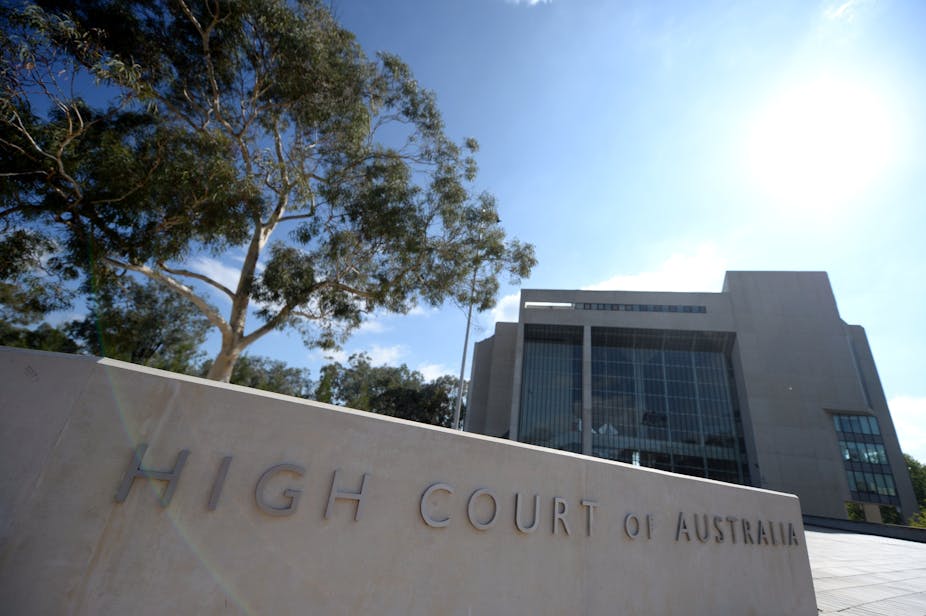On Wednesday, the High Court handed down an important judgment on the legality of the interception of asylum seeker vessels and the detention of those onboard on the high seas. It ruled, by a 4:3 majority, that the Sri Lankan asylum seekers held at sea in 2014 on a Customs vessel were detained lawfully. No damages will be awarded to them.
The judgment is important given that the Coalition government made a political promise to “stop the boats” and it appears that it now has a broad power to do so.
The case stems from action taken in late June 2014, when Australian authorities intercepted a boat from India carrying 157 Sri Lankan Tamil asylum seekers and detained them on an Australian customs vessel for 29 days. The detention was carried out while the Australian government negotiated with India to receive the asylum seekers. In the end, the asylum seekers were brought to the Australian mainland and then transferred to Nauru.
What issues did the court consider?
There were two major legal issues before the High Court. The first was the source of the government’s power to intercept and detain. The government argued that it was so permitted under either the Maritime Powers Act or its inherent executive power under Section 61 of the Constitution.
The second legal question was whether the government was obliged to accord the asylum seekers any due process protections such as a hearing.
The question of the source of the government’s power to detain asylum seekers at sea is important. Australia does not have a wide legal jurisdiction outside national boundaries. It only has a limited jurisdiction to take such action to investigate or prevent a contravention of the Migration Act. That power is set out both in the international Law of the Sea and the Maritime Powers Act.
The government argued that because boat arrivals do not hold a visa, they are acting in contravention of Australian law. As such, the government is permitted to intercept and detain them to stop them entering our territory.
What did the court find?
As to the first question, the High Court found that the detention was linked to the Maritime Powers Act – that is, it was necessary to prevent a contravention of the Migration Act. The judgment is complex, but the crux of the decision is the wording of Australian domestic legislation.
Section 72(4) of the Maritime Powers Act clearly states that a maritime officer may detain a person on a vessel and take the person to a place outside Australia. The plaintiffs had argued that this must be read in line with Australia’s international law obligations, including the prohibition on returning asylum seekers to persecution in breach of the so-called “non-refoulement principle”.
In the majority decision, Chief Justice Robert French held that there was nothing in Section 72(4) of the Maritime Powers Act that suggested it could be limited by Australia’s non-refoulement obligations.
Because the High Court made such a ruling, it said it was not necessary to rule on the remit of the government’s constitutional executive power.
While it was not strictly necessary for the High Court to address that question, it would have been helpful to have received guidance on that. This is because the scope of the government to act under its constitutional executive power remains a murky legal question. The ability of the government to expel asylum seekers from Australian waters was one of the issues raised during the Tampa litigation in 2001 and has not yet been definitively answered by the High Court.
Even though the High Court’s ruling represents a legal setback for the plaintiffs concerned, it is important because it gives guidance on how to interpret the Maritime Powers Act. This act was passed only in 2013 and has not yet been the subject of judicial scrutiny by the High Court.
What legal issues remain unresolved?
To some extent, the High Court’s decision has already been overtaken by changes made to Australian migration legislation by the Migration and Maritime Powers Legislation Amendment (Resolving the Asylum Legacy Caseload) Bill 2014. This was the controversial legislation passed by the Senate on the last sitting day of parliament in 2014.
This bill clarified the legal position about international law by removing references to Australia’s non-refoulement obligations from domestic law and expanding the powers of the immigration minister over vessels in the Maritime Powers Act.
However, serious legal questions arise from those changes, which this High Court decision did not address. One such question is the possibility that detention under the Maritime Powers Act can be indefinite. This arises because some of the protections set out in the previous Maritime Powers Act were removed after the High Court heard the current case.
More broadly, both the High Court decision and the changes to the Maritime Powers Act raise concerns about the rights of asylum seekers who are detained at sea – a place where they have no access to legal advice nor ability to be heard. They are particularly vulnerable to abuses of power. It is therefore highly likely that these issues will continue to be litigated before the High Court.

